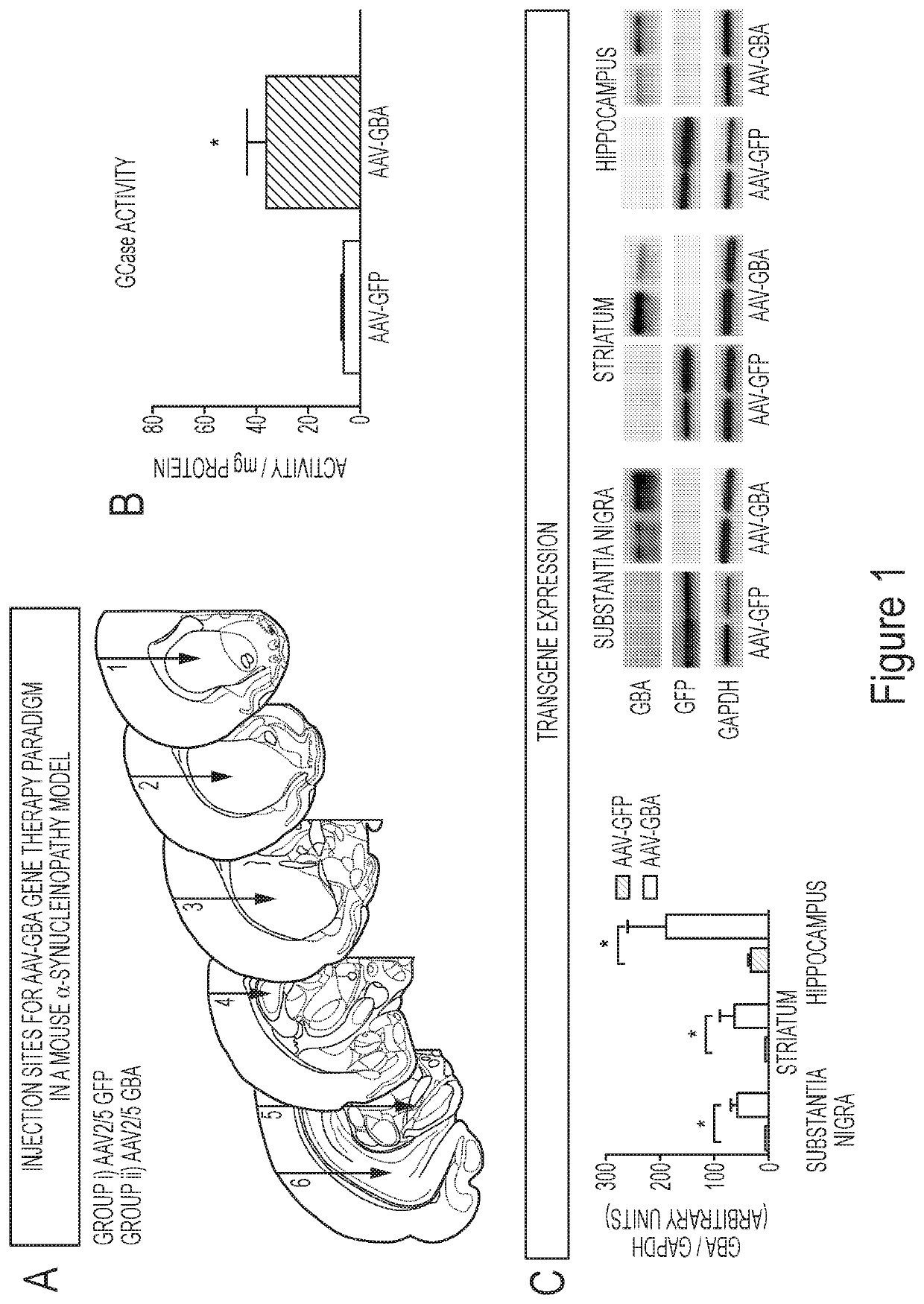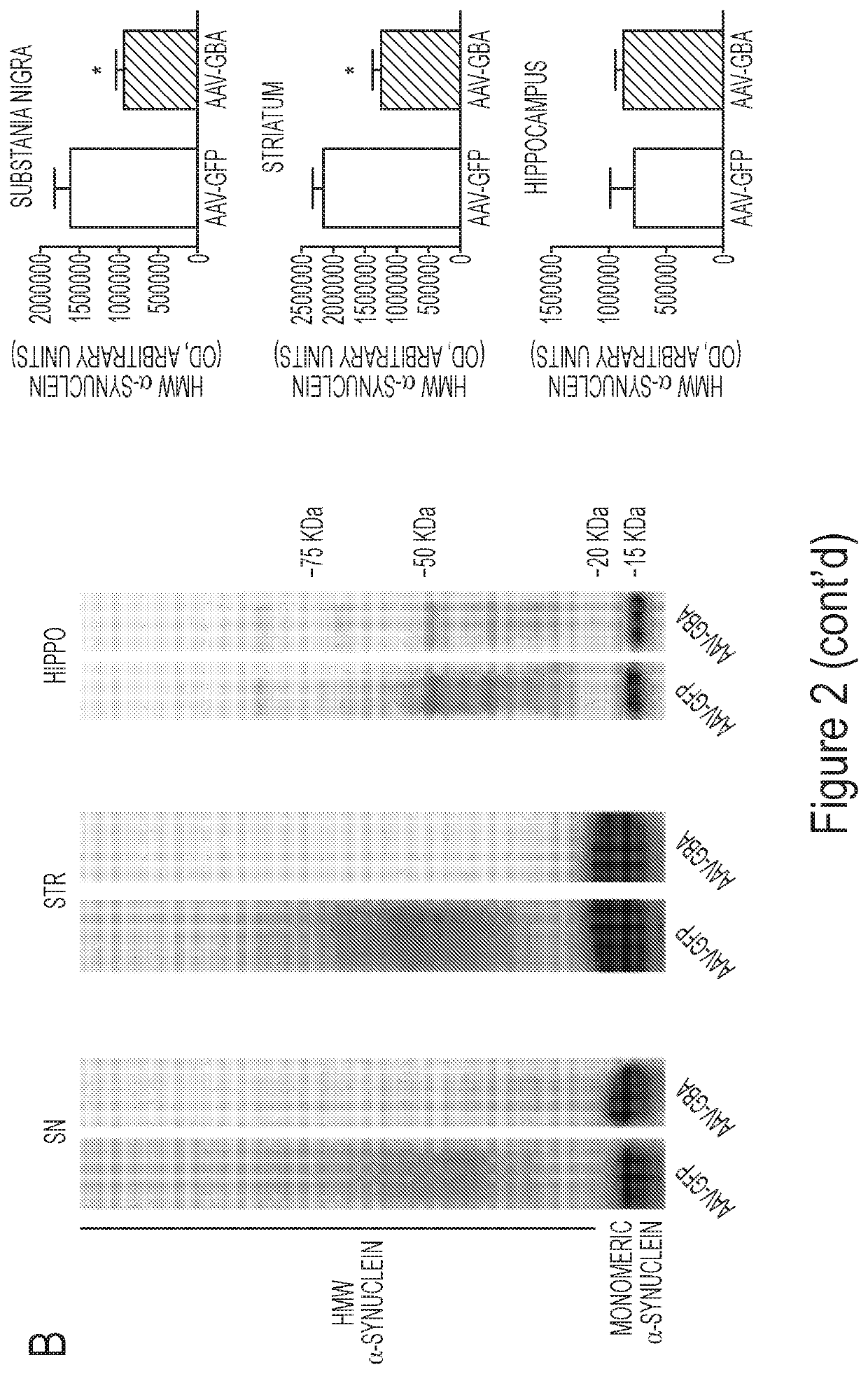Glucocerebrosidase gene therapy for Parkinson's disease
a technology of glucocerebrosidase and parkinson's disease, which is applied in the direction of genetic material ingredients, drug compositions, peptide/protein ingredients, etc., can solve the problems of symptom typically continuing to worsen, and achieve the effects of preventing or delaying the onset of the disease, and reducing the severity or frequency of the diseas
- Summary
- Abstract
- Description
- Claims
- Application Information
AI Technical Summary
Benefits of technology
Problems solved by technology
Method used
Image
Examples
example 1
Glucocerebrosidase Gene Delivery Reduces Symptoms of PD
[0197]The present example demonstrates that GBA1 gene delivery reduces the number and size of insoluble α-synuclein aggregates in mice overexpressing human wild type α-synuclein. Some of the experiments described herein address whether overexpression of glucocerebrosidase activity could decrease levels of the oligomeric and aggregated forms of α-synuclein. To achieve overexpression of glucocerebrosidase (GBA1) in the striatum, substantia nigra and hippocampus, unilateral injections of either AAV-GBA1 or AAV-GFP control were delivered to 2-month old ASO mice (Panel A of FIG. 1 and Panel C of FIG. 1).
[0198]Glucocerebrosidase activity was quantified in the brain of ASO mice 3-months post AAV-injection. A 3-fold increase (T1,7=5.53, p1,7=4.033, p1,7=2.60, p1,7=2.496, p<0.05).
[0199]At 5-months of age, when ASO mice display modest pathology, AAV-GBA1 injection induced autophagosome formation (Panel A of FIG. 2), which was paralleled b...
example 2
Glucocerebrosidase Gene Therapy is Neuroprotective
[0202]This example demonstrates the neuroprotective effects of overexpressing GBA1. In particular, the present example demonstrates that gene delivery of GBA1 protects nigrostriatal dopaminergic neurons from degeneration. GBA1 gene delivery was tested using a rat model of α-synucleinopathy, in which a 50% reduction in TH-positive neurons and accumulation of misfolded α-synuclein are observed, 24 weeks post-AAV injection. This differs from the model of Example 1, which manifests a progressive and widespread accumulation of insoluble α-synuclein but does not cause a loss of the TH-positive DA neurons in the substantia nigra.
[0203]Naïve rats received an intra-nigral injections of either (1) AAV-GFP (control), (2) AAV-GFP+AAV-mutant A53T α-synuclein, or (3) AAV-GBA1+AAV-mutant A53T α-synuclein (Panel A of FIG. 4). GBA1 gene delivery caused an increase in Glucocerebrosidase activity (F2,11=32.34, p2,11=9.994, p<0.05) in the substantia nig...
example 3
Overexpression of Glucocerebrosidase Restores Macroautophagy-Related Protein Expression
[0205]This example demonstrates that overexpression of glucocerebrosidase induced macroautophagy and / or chaperone-mediated autophagy. Proteins involved in both pathways were explored at a pre-degenerative time point, 8-weeks post AAV-gene delivery. Specifically, Western blots were performed using total lysate from the substantia nigra and the striatum of naïve rats that received intra-nigral injections of (1) AAV-GFP (control), (2) AAV-GFP+AAV-mutant A53T α-synuclein or (3) AAV-GBA1+AAV-mutant A53T α-synuclein. At 8-weeks post gene delivery, levels of the lipidated form of LC3 (LC3-II) remained unchanged in the substantia nigra (Panel A of FIG. 6). However, levels of LC3-II significantly decreased (F211=8.15, p2,10=5.45, p2,12=5.98, p<0.05) in the striatum (Panel D of FIG. 6). The chaperone-mediated autophagy receptor LAMP-2A remained unchanged in the substantia nigra and striatum following a co-i...
PUM
| Property | Measurement | Unit |
|---|---|---|
| magnetic field | aaaaa | aaaaa |
| frequency | aaaaa | aaaaa |
| concentration | aaaaa | aaaaa |
Abstract
Description
Claims
Application Information
 Login to View More
Login to View More - R&D
- Intellectual Property
- Life Sciences
- Materials
- Tech Scout
- Unparalleled Data Quality
- Higher Quality Content
- 60% Fewer Hallucinations
Browse by: Latest US Patents, China's latest patents, Technical Efficacy Thesaurus, Application Domain, Technology Topic, Popular Technical Reports.
© 2025 PatSnap. All rights reserved.Legal|Privacy policy|Modern Slavery Act Transparency Statement|Sitemap|About US| Contact US: help@patsnap.com



